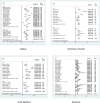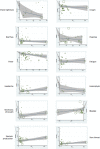Determine the most common clinical symptoms in COVID-19 patients: a systematic review and meta-analysis
- PMID: 33150219
- PMCID: PMC7595075
- DOI: 10.15167/2421-4248/jpmh2020.61.3.1530
Determine the most common clinical symptoms in COVID-19 patients: a systematic review and meta-analysis
Abstract
Introduction: COVID-19 is an emerging infectious disease. The study about features of this infection could be very helpful in better knowledge about this infectious disease. The current systematic review and meta-analysis were aimed to estimate the prevalence of clinical symptoms of COVID-19 in a systematic review and meta-analysis.
Methods: A systematic review using Medline/PubMed, Scopus, and Google scholar has been conducted. In the current systematic review and meta-analysis, the articles published in the period January 1, 2020, to April 2, 2020, written in English and reporting clinical symptoms of COVID-19 was reviewed. To assess, the presence of heterogeneity, the Cochran's Q statistic, the I2 index, and the tau-squared test were used. Because of significant heterogeneity between the studies the random-effects model with 95% CI was used to calculate the pooled estimation of each symptom prevalence.
Results: The most common symptoms in COVID-19 patients include: Fever 81.2% (95% CI: 77.9-84.4); Cough: 58.5% (95% CI: 54.2-62.8); Fatigue 38.5% (95% CI: 30.6-45.3); Dyspnea: 26.1% (95% CI: 20.4-31.8); and the Sputum: 25.8% (95% CI: 21.1-30.4). Based on the meta-regression results, the sample size used in different studies did not have a significant effect on the final estimate value (P > 0.05).
Conclusions: Considering the main symptoms of COVID-19 such as Fever, Cough, Fatigue, and Dyspnea can have a key role in early detection of this disease and prevent the transmission of the disease to other people.
Keywords: COVID-19; Clinical symptoms; Meta-analysis.
©2020 Pacini Editore SRL, Pisa, Italy.
Figures



References
-
- Bonilla-Aldana D, Dhama K, Rodriguez-Morales AJ. Revisiting the one health approach in the context of COVID-19: a look into the ecology of this emerging disease. Adv Anim Vet Sci 2020;8:234-7. https://doi.org/10.17582/journal.aavs/2020/8.3.234.237 10.17582/journal.aavs/2020/8.3.234.237 - DOI
-
- Alimohamadi Y, Taghdir M, Sepandi M. The estimate of the basic reproduction number for novel coronavirus disease (COVID-19): a systematic review and meta-analysis. J Prev Med Public Health 2020; 53(3):151-157. https://doi.org/10.3961/jpmph.20.076 10.3961/jpmph.20.076 - DOI - PMC - PubMed
-
- Chen T, Wu D, Chen H, Yan W, Yang D, Chen G, Ma K, Xu D, Yu H, Wang HJB. Clinical characteristics of 113 deceased patients with coronavirus disease 2019: retrospective study. bmj 2020;368 https://doi.org/10.1136/bmj.m1091 10.1136/bmj.m1091 - DOI - PMC - PubMed
-
- Petrosillo N, Viceconte G, Ergonul O, Ippolito G, Petersen E. COVID-19, SARS and MERS: are they closely related? Clinical Microbiology and Infection. 2020;26:729-734. https://doi.org/10.1016/j.cmi.2020.03.026 10.1016/j.cmi.2020.03.026 - DOI - PMC - PubMed
Publication types
MeSH terms
LinkOut - more resources
Full Text Sources
Other Literature Sources
Miscellaneous
